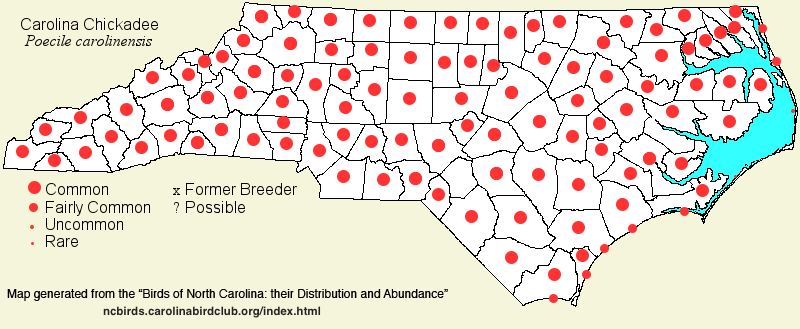 |  |
|
Carolina Chickadee - Poecile carolinensis PARIDAE Members: | Search Common: Search Scientific: |
|
|
|||||||
| General Comments | The Carolina Chickadee is one of the best known species in the state, as it occurs statewide, and nests in all 100 counties. It is absent only from the highest mountains and the Outer Banks (and other islands with no forests). It is one of the relatively few songbirds in the state that is completely non-migratory. Year-round habitat is middle-aged to mature forests and woodlots, both in residential areas and in more remote areas. It favors some conifers in the forest, especially in winter; however, they range from swamp forests to drier forests. Nearly all bird feeders in wooded areas are visited by chickadees. It is a nucleus species, along with the Tufted Titmouse, in the mixed-species flocks that roam the pine and mixed forests in winter. | ||||||
| Breeding Status | Breeder | ||||||
| NC BRC List | Definitive | ||||||
| State Status | |||||||
| U.S. Status | |||||||
| State Rank | S5 | ||||||
| Global Rank | G5 | ||||||
| Coastal Plain | Permanent resident; non-migratory. Common to very common, and widespread, across the region, except absent on barrier islands lacking forests. Mysteriously absent from Buxton Woods, which contains excellent habitat for the species, though there are one or two records. There are also a few records for the Cape Lookout area, presumably representing strays from the nearby mainland. Peak counts: | ||||||
| Piedmont | Permanent resident; non-migratory. Common to very common, and widespread, across the province. Peak counts: 283, Jordan Lake spring count, 7 May 2000. | ||||||
| Mountains | Permanent resident; non-migratory. Common to very common, and widespread, up to 5,500 feet, to occasionally 6,000 feet, except in areas occupied by the Black-capped Chickadee. Thus, in much of the Great Smoky Mountains NP, the Plott Balsams, and the Great Balsam Mountains southeast toward Devils Courthouse, the species ranges up to about 4,500 feet -- or to the elevation occupied by the Black-capped (the two species do not occur in the same area). Peak counts: | ||||||
| Finding Tips |
None needed. **** | ||||||
| Attribution | LeGrand[2023-03-26], LeGrand[2012-09-16], LeGrand[2011-12-11] | ||||||
| NC Map Map depicts all counties with a report (transient or resident) for the species. | Click on county for list of all known species. |
| NC Breeding Season Map Map depicts assumed breeding season abundance for the species. |  |